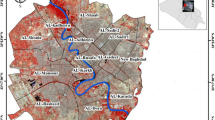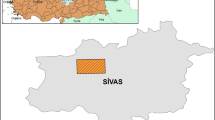Abstract
Akure is one of the cities undergoing rapid growth in Nigeria, which has resulted to remarkable Urban Heat Island (UHI) effect. To examine the impact of this development in the city and its environs, this study derived the brightness temperatures and land use land cover (LULC) types using Landsat images between 1984 and 2016, of 190/55 path and row. Normalized Difference Built up Index (NDBI) and Normalized Difference Vegetation Index (NDVI), were used as LULC indicators for sub-pixel analysis. The results of this study revealed a remarkable change in built-up area at the expense of vegetation (forest) and bare lands. The sub-pixels analysis between land use/cover indicators and temperature revealed a strong correlation between LULC and temperature in the area. Findings revealed a 4.63 °C temperature increase in vegetated areas between 1984 and 2016; and an overall temperature values ranged from about 14 to 36 °C, which have been categorized into six classes (< 20 °C, 20 °C to < 24 °C, 24 °C to < 28 °C, 28 °C to < 32 °C, and ≥ 32 °C). The temperature increase over the years and the strong correlation between temperature and land use land cover suggests, that any small undesirable change in land use land cover in the future would lead to severe environmental condition.




Similar content being viewed by others
References
Abd HAA-R, Alnajjar HA (2013) Maximum likelihood for land-use/land-cover mapping and change detection using landsat satellite images: a case study “South Of Johor”. Int J Comput Eng Res 03(6):26–33
Aderoju OM, Samakinwa EK, Ibrahim D (2013) An assessment of urban heat island in Akure using geospatial techniques. J Environ Sci Toxicol Food Technol 6(3):24–34
Agbor CF, Makinde EO (2018) Land surface temperature mapping using geoinformation techniques. Geoinf FCE CTU 15:17. https://doi.org/10.14311/gi.17.1.2
Ahmed B, Ahmed R (2012) Modeling urban land cover growth dynamics using multi temporal satellite images: a case study of Dhaka, Bangladesh. ISPRS Int J Geo Inf 2012(1):3–31
Akbari H, Konopacki S (2002) Energy savings for heat-island reduction strategies in Chicago and Houston (including updates for Baton Rouge, Sacramento, and Salt Lake City). Technical Report, Lawrence Berkeley National Lab (LBNL), Berkeley, CA (United States). https://doi.org/10.2172/795970
Akbari Hashem, Konopacki Steven (2004) Energy effects of heat-island reduction strategies in Toronto, Canada. Energy 29:191–210. https://doi.org/10.1016/j.energy.2003.09.004
Akbari H (2005) Energy saving potentials and air quality benefits of urban heat island mitigation (No LBNL-58285). Ernest Orlando Lawrence Berkeley National Laboratory, Berkeley, CA, US
Anderson JR, Hardy EE, Roach JT, Witmer RE (1976) A land use and land cover classification system for use with remote sensor data, Professional Paper 964. A revision of the land use classification system in Circular 671
Arekhi S (2011) Modeling spatial pattern of deforestation using GIS and logistic regression: a case study of Northern Ilam forests, Ilam province. Iran. Afr J Biotechnol 10(72):16236–16249
Avdan U, Jovanovska G (2016a) Automated mapping of land surface temperature using LANDSAT 8 satellite data. J Sens 2016:1480307
Avdan U, Jovanovska G (2016b) Algorithm for automated mapping of land surface temperature using LANDSAT 8 satellite data. J Sens 1480307:8
Bayes A, Kamruzzaman Md., Zhu X, Rahman S, Choi K (2013) Simulating land cover changes and their impacts on land surface temperature in Dhaka, Bangladesh
Benoit K (2011) Linear regression models with logarithmic transformations. Lond Sch Econ Lond 22(1):23–36
Bowler DE, Buyung-Ali LM, Knight T, Pullin AS (2010) Urban greening to cool towns and cities: a systematic review of the empirical evidence. Landscape Urban Plan 97(3):147–155
Field B, MacGregor BD (1993) Forecasting technique for urban and regional planning. Nelson Thornes Ltd, Cheltenham, United Kingdom
Carletta J (1996) Assessing agreement on classification tasks: the Kappa statistic. Human Communication Research Centre, 2 Buccleuch Place, Edinburgh EH8 9LW, Scotland
Chander G, Markham BL, Helder DL (2009) Summary of current radiometric calibration coefficients for Landsat MSS, TM, ETM + , and EO-1 ALI sensors. Remote Sens Environ 113(5):893–903
Changnon SA, Kunkel, KE, Reinke BC (1996) Impacts and responses to the 1995 heat wave: a call to action. Bull Am Meteorol Soc 77(7):1497–1506
Chen Y, Wang J, Li X (2002) A study on urban thermal field in summer based on satellite remote sensing. Remote Sens Land Resour 14(4):55–59
Congalton RG (1991) A review of assessing the accuracy of classifications of remotely sensed data. Remote Sens Environ 37:35–46. https://doi.org/10.1016/00344257(91)90048-B
Gallo KP, Owen TW (1998) Assessment of urban heat island: a multisensory perspective for the Dallas-Ft. Worth, USA region. Geocarto Int 13:05–018
Giannini MB, Belfiore OR, Parente C, Santamaria R (2015) Land surface temperature from Landsat 5 TM images: comparison of different methods using airborne thermal data measurements and comparison with MODIS remote sensing estimates. Agric Forest Meteorol 129:151–173
Gill SE, Handley JF, Ennos AR, Pauleit S (2007) Adapting cities for climate change: the role of green infrastructure. Built Environ 33:115–133
Givoni B (1991) Impact of planted areas on urban environmental quality: a review. Atmos Environ 25:289–299
Hashim NB, Ahmad A, Abdullah M (2007) Mapping urban heat island phenomenon: remote sensing approach. Instit Eng Malaysia 68:25–30
Heat Island Group (2005) Proceedings of the 1st international passive and low energy cooling for the built environment 2005, p. 11
IDRISI Selva Manual 2012 (2012) Clark University, Worcester
IPCC (2014) Climate change 2014: synthesis report. Contribution of working groups I, II and III to the fifth assessment report of the intergovernmental panel on climate change [Core Writing Team, Pachauri RK, Meyer LA (eds)]. IPCC, Geneva, Switzerland, 151 pp
Jensen JR (1996) Introductory digital image processing: a remote sensing perspective, 3rd edn. Pearson Prentice Hall, Upper Saddle River
Katpatal Y, Kute A, Satapathy DR (2009) Surface-and air-temperature studies in relation to land use/land cover of Nagpur urban area using landsat 5 TM data. J Urban Plan Dev 134:15. https://doi.org/10.1061/ASCE0733-94882008134:3110
Landsberg HE (1981) The urban climate. International geophysics series, vol 28. Academic Press, New York, NY, USA, 278p
Laosuwan T, Sangpradit S (2012) Urban heat island monitoring and analysis by using integration of satellite data and knowledge based method. Int J Dev Sustain 1(2):99–110
Li J, Song C, Cao L, Zhu F, Meng X, Wu J (2011) Impacts of landscape structure on surface urban heat islands: a case study of Shanghai, China. Remote Sens Environ 115(12):3249–3263
Liao L, Zhang L, Bengtsson L (2005) Analyzing dynamic change of vegetation cover of desert oasis based on remote sensing data in Hexi region. In: Proceeding of international symposium on sustainable water resources management and oasis-hydrosphere-desert interaction in arid regions, Beijing, pp 279–295
Lillesand TM, Kiefer R (2008) Remote sensing image interpretation. Wiley, New York
Lin L, Zhang Y (2011) Urban heat island analysis using the landsat TM data and ASTER data: a case study in Hong Kong. Remote Sens 2011(3):1535–1552. https://doi.org/10.3390/rs3071535
Lu Y, Feng P, Shen C, Sun (2009) Urban heat island in summer of Nanjing based on TM data. In: Proceedings of 2009 joint urban remote sensing event, Shanghai, China, 20, pp 1–5
Luck M, Wu J (2002) A gradient analysis of urban landscape pattern: a case study from the Phoenix metropolitan region, Arizona, USA. Landsc Ecol 17(4):327–339
Mango LM (2010) Modeling the effect of land use and climate change scenarios on the water flux of the upper mara river flow, Kenya. FIU Electronic Theses and Dissertations. 159. 10.25148/etd.FI10041632 https://digitalcommons.fiu.edu/etd/159
Monica Cavinaw Geography 581 (2007) A modified version of the anderson scheme of land use/cover classification, excerpt from Anderson et al. A land use and land cover classification system for use with remote sensor data (1976)
Nastaran S (2014) The impacts of green areas on mitigating urban heat island effect. Int J Environ Sustain 9:119–130. https://doi.org/10.18848/2325-1077/CGP/v09i01/55081
National Bureau of Statistics: National Population commission of Nigeria (2010) Annual Abstract of Statistics
Nowak DJ, Crane DE, Stevens JC, Ibarra M (2002) Brooklyn’s urban forest. United States Department of Agriculture, Forest Service, North-eastern Forest Experiment Station, General Technical Report NE-290, Radnor PA
Oke TR (1989) The micrometerology of the urban forest. Philos Transac Royal Soc B Biol Sci 324:335–349
Olofsson P, Foody GM, Herold M, Stehman S, Woodcock CE, Wulder M (2013) Good practices for assessing accuracy and estimating area of land change. Remote Sens Environ. https://doi.org/10.1016/j.rse.2014.02.015
Owen TW, Carlson TN, Gillies RR (1998) An assessment of satellite remotely-sensed land cover parameters in quantitatively describing the climatic effect of urbanization. Int J Remote Sens 19:1663–1681
Rawat JS, Kumar M (2015) Monitoring land use/cover change using remote sensing and GIS techniques: a case study of Hawalbagh block, district Almora, Uttarakhand, India. Egypt J Remote Sens Space Sci. https://doi.org/10.1016/j.ejrs.2015.02.002
Pickett ST, Cadenasso ML, Grove JM, Nilon CH, Pouyat RV, Zipperer WC, Costanza R (2001) Urban ecological systems: linking terrestrial ecological, physical, and socioeconomic components of metropolitan areas. Ann Rev Ecol Evol Syst 32:127–157
Rosenfeld AH, Akbari H, Romm J, Pomerantz M (1998) Cool communities: strategies for heat island mitigation and smog reduction. Energy Build 28(1):51–62
Sanga L, Zhanga C, Yanga J, Zhua D, Yunb W (2011) Simulation of land use spatial pattern of towns and villages based on CA–Markov model. Journal www.elsevier.com/locate/mcm
Schneider P, Ghent D, Corlett G, Prata F, Remedios J (2012). LST validation protocol earth observation Science, Space Research Centre, Department of Physics & Astronomy, University of Leicester
Shaharuddin A (1997) Urbanization and human comfort in Kuala Lumpur-Petaling Jaya, Malaysia. Ilmu Alam 23:171–189
Shen G, Abdoul NI, Zhu Y, Wang Z, Gong J (2017) Remote sensing of urban growth and landscape pattern changes in response to the expansion of Chongming Island in Shanghai. China. Geocarto Int 32(5):488–502
Taha H (1997) Urban climates and heat islands: albedo, evapotranspiration, and anthropogenic heat. Energy Build 25:99–103
Tam KC, Lim HS, MatJafri MZ, Abdullah K (2010) Landsat data to evaluate urban expansion and determine land use/land cover change in Penang Island, Malaysia. Environ Earth Sci 60:1509–1521
Tian Q, Xiangjun M (1998) Advances in study on vegetation indices. Adv Earth Sci 13(4):020
United State Environmental Protection Agency (2015). 11(1). https://www.epa.gov/
Voogt J (1989) Urban Heat Island. Encycl Global Environ Change 3:660–666
Weng Q, Lu D, Schubring J (2004) Estimation of land surface temperature–vegetation abundance relationship for urban heat island studies. Remote Sens Environ 89(2004):467–483
Xiao-Ling C, Hong-Mei Z, Ping-Xiang L, Zhi-Yong Y (2005) Remote sensing image-based analysis of the relationship between urban heat island and land use/cover changes. Remote Sens Environ 104(2):133–146. https://doi.org/10.1016/j.rse.2005.11.016
Zhao HM, Chen XL (2005) Use of normalized difference bareness index in quickly mapping bare areas from TM/ETM+. Geosci Remote Sens Symp 3(2529):1222–1228
Author information
Authors and Affiliations
Corresponding author
Additional information
Publisher's Note
Springer Nature remains neutral with regard to jurisdictional claims in published maps and institutional affiliations.
Rights and permissions
About this article
Cite this article
Makinde, E.O., Agbor, C.F. Geoinformatic assessment of urban heat island and land use/cover processes: a case study from Akure. Environ Earth Sci 78, 483 (2019). https://doi.org/10.1007/s12665-019-8433-7
Received:
Accepted:
Published:
DOI: https://doi.org/10.1007/s12665-019-8433-7




